- Submissions

Full Text
Novel Research in Sciences
Effects of Different Light Spectrums on Kailan (Brassica Oleraceae Var. Alboglabra) Growth in Hydroponics (NFT)
Shanmugavadivu Ramasamy*, Kit Lun Chan, Kay Yee Tan, Ganapathy Rajaseger, Mar Cho Khin and Kadamb Patel
School of Applied Science, Temasek Polytechnic, Singapore
*Corresponding author:Shanmugavadivu Ramasamy, School of Applied Science, Temasek Polytechnic, East Wing Block 1A, 21 Tampines Ave 1, 529757 Singapore
Submission: August 14, 2023;Published: September 19, 2023
.jpg)
Volume15 Issue1September , 2023
Abstract
In densely populated cities like Singapore, ensuring a stable supply of nutritious food is a growing concern. With limited land availability for traditional farming methods, the need for high-tech urban farming has become evident. Indoor farming offers a promising solution to address food insecurity and meet the rising demand for locally sourced produce. Currently, local farming in Singapore contributes only 10% of the leafy vegetables consumed, highlighting the urgency to increase this percentage to 30% within the next decade [1]. To achieve this ambitious goal, the implementation of controlled indoor farming is essential. However, indoor farming requires a reliable and uniform source of light, not only for food production but also to induce proper morphogenesis in plants [2,3]. Light is a fundamental factor in plant growth and development, making it crucial to select an appropriate light source. LED technology has emerged as a viable option for providing uniform light in closed plant farming practices. Different vegetable crops have varying requirements for light duration and intensity. Thus, understanding the impact of various wavelength Light-Emitting Diodes (LED) on the photosynthetic parameters of Brassica species becomes pivotal. Brassica is not only known for its nutritional value, including fats, proteins, and natural antioxidants [4], but it is also an ideal candidate for hydroponic cultivation due to its adaptability and nutrient-rich properties [5]. Hydroponics, a soilless farming method, utilizes nutrient-rich water as a medium to supply essential elements to plants. The Nutrient Film Technique (NFT) is a popular hydroponic system where a thin film of nutrient solution flows over the plant roots, providing them with a continuous supply of nutrients. The primary objective of this study is to investigate the impact of different light spectrums on the growth of Kailan (Brassica oleraceae var. alboglabra) in a hydroponic NFT system. three different light treatments were employed in the NFT hydroponic system: blue light (400-500nm), red light (600- 700nm), and white light. Each light spectrum’s effects on Kailan growth were meticulously monitored and compared. By identifying the most suitable light spectrum for Kailan growth in an NFT hydroponic system, we can develop efficient and sustainable practices to support urban agriculture.
Keywords:Hydroponics; NFT; Indoor farming; Controlled environment; Light duration
Materials and Methods
Plant materials and growing conditions
Seeds: The seeds which used for this experiment was issue to the team were provided by TP. These seeds were supplied by Ban Lee Huat Seed and these seeds has been specially selected to have higher temperature tolerance and suitable for grow in Singapore (Figure 1).
Figure 1:Seeds.
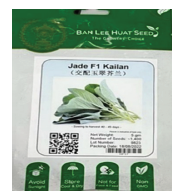
Nutrient solution: The Hydroponic nutrients solution consist of Part A and Part B (5ml+5ml in 1liter of water) solution specially for leafy greens. The nutrients solution bought from water circle. Singapore (Figure 2).
Figure 2:Nutrient solution.
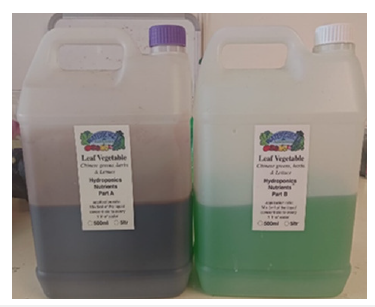
Equipment’s used for the experiment
(Figure 3)
Figure 3:Equipment’s used for the experiment.

Materials required
Sponge cubes, Seedling tray, plastic net cups for hydroponics, water, Light sensors, drying oven, graph paper.
Growing parameters: (Table 1)
Table 1:Growing parameters.

Preparation for seed germination: A clean plastic tray was taken, and it was filled with sponge cubes used for seed germination. The sponge cubes were soaked with water, squeezed and released them to remove the air and wet them thoroughly. The seeds were placed into the slits found on the surface of the sponge cubes, sprayed them with water to moisten the seeds and covered them with a base tray. The tray was then incubated in the dark for 48 hours. After 24 hours of incubation, sprayed the seeds with water to avoid dryness. As the Germination is done directly on the growing sponge, this can omit the needs to transfer the seeds to the growing medium during the later stage when the true leaf appears. As the true leaf appeared, the energy store in the seed will be repleaded and the plant will need to rely on nutrient to grow. During the first week of transfer, half strength of nutrient will be introduced to the plant this is to avoid root burnt.
Select only the sunken seeds from the pre-soak container. Using a tweezer and place the seed in the middle of the sponge. Place the seed approximately 2 to 3 times of its length [1] with root side pointing downward. This can assist the Cotyledon from needing to rotate while breaking out from the Testa.
Preparation of hydroponic plant growth racks (NFT): The hydroponic plant growth rack shelves were cleaned and checked that all the LED tubes were connected and fixed correctly to the tube light holders. Using the light sensors, checked and adjusted the light intensity to the required intensity of 200 PPFD (Photosynthetic Photon Flux Density).
Shifting to light: The cover was removed, and sprayed water on all the seed germination sponge cubes. Then, shifted all the sponge cubes to the growth racks with LED lights adjusted to 200 PPFD.
Seed germination rate measurement
counted the number of seeds germinated and recorded it from day 2 to 7. calculated the percentage of seed germination using the total number of seeds used and the number of seeds germinated every day. The seedlings were grown for 7 days, and observations on seedling growth, such as true leaf formation and the number of true leaves was done.
Transfer of seed germinating sponge cubes into plastic net cups: After that gently transferred each sponge cube with the germinated seedling into the plastic net cups without damaging the seedling roots.
Preparation of hydroponic nutrient solution: Carefully mixed an equal amount (1 litre each) of the provided A and B nutrient solutions into the reservoir tank of the hydroponics system, which was half-filled with water. I added more nutrient solutions or water to adjust the solution concentration to EC 2 and checked the pH of the nutrient solution.
Plant care and measurements: Nutrient solutions (equal
amounts of A and B) to maintain the nutrient solution concentration
at EC2 and the pH of the nutrient solution in the reservoir tank of
the hydroponics system. Then observations were recorded on plant
growth, every week for four weeks. Growth parameters observed:
A. Seed germination
B. True leaf numbers
C. Height of the plant
D. Chlorophyll content
E. Girth of internode
F. Leaf Area
G. Fresh weight
H. Dry Weight
I. PPFD
J. Temperature
K. Relative humidity
Hydroponic plant growth racks with LED lights: The light spectrums tested were blue light (400-500nm), red light (600- 700nm), and white light. The photoperiod was set to 10 hours of light and 14 hours of dark with an automatic control system along with temperature and Humidity sensor (Figure 4).
Figure 4:Hydroponic Plant growth racks with LED Lights.
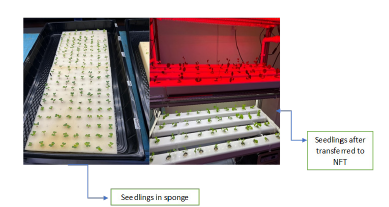
Plant harvest and final data collection: End of the 5th week, harvest the plants and measure and record the fresh weight of each plant. Remove three leaves from the base and measure the leaf area using a leaf area meter. Then wrap the plants with aluminium foil, label them and place them into a drying oven (70 °C). Record the weight of dried plants after 24 and 48 hours (Figure 5 & 6).
Figure 5:Plant harvest and final data collection.

Figure 6:Leafy vegetables growth in Hydroponics- (Nutrient Film Technique).
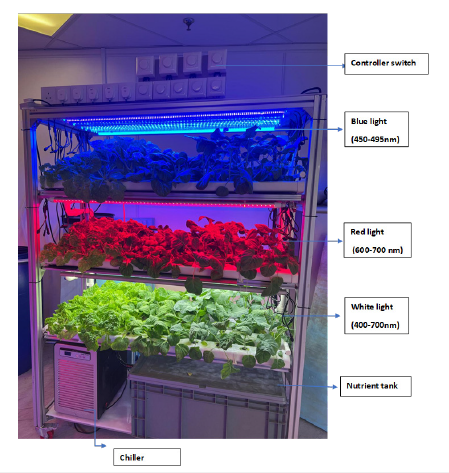
Result & Discussion
The effect of LEDs sources on the growth parameters of Kailan seedlings were recorded for weekly intervals up to week five at the end of the harvesting (Figure 7).
Figure 7:After harvesting shoot and root system of Kailan under different lights.

Germination percentage
The results indicated that the hydroponic Kailan, the germination percentage was recorded 45% on day 2 and 75% was recorded on day 3 and during 7th day 97% of the seeds were germinated.
Height of the plant
The experiment aimed to investigate the effect of different light spectrums on the height of kailan plants over a period of 5 weeks. Three light conditions, namely BLUE, RED, and WHITE, were tested to understand their impact on plant growth. At the initial stage (Week-1), the plants under all three light spectrums showed relatively similar heights, with slight variations. The WHITE lights exhibited slightly higher initial growth compared to the BLUE and Red lights. By the second week, the plants under BLUE and RED light had experienced significant growth, while the WHITE light group continued to demonstrate consistent growth. The BLUE light had a notably higher growth rate compared to the other groups. As the plants entered Week-3, the differences in growth rates became more apparent.
The BLUE light exhibited robust growth, surpassing the other groups in height. In the fourth week, the plants under all light spectrums experienced substantial growth, with the BLUE light maintaining its lead. However, the RED light showed a slower growth rate, and the WHITE light caught up and almost matched the growth of the RED light. By the final week, the Kailan plants under all three light conditions reached considerable heights. The BLUE light continued to exhibit the tallest plants, with the RED and WHITE lights following closely. The comparative analysis of the results revealed the significant influence of different light spectrums on the growth of Kailan plants over the 5-week period. Among the three light conditions tested, the BLUE light spectrum proved to be the most effective in promoting rapid and robust plant development. Throughout the experiment, the Kailan plants under BLUE light consistently exhibited the tallest heights, outpacing the other groups. The RED-light spectrum also supported healthy growth, though at a slightly slower pace compared to the BLUE light. Meanwhile, the WHITE light spectrum demonstrated a steady, intermediate effect on plant height. These findings provide valuable insights into optimizing indoor farming and greenhouse environments, where tailored light spectrums can be employed to enhance crop growth and maximize yields (Figure 8).
Figure 8:Height of Kailan plant (cm)..
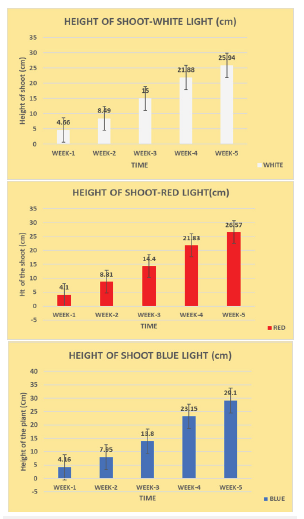
True leaf
The experiment aimed to investigate the growth of Kailan plants and the development of true leaves under different light spectrums over a 5-week period. The recorded data for the number of true leaves at each week for each light condition (BLUE, RED, and WHITE) are presented.
In the initial week, all three light conditions showed relatively similar development, with the WHITE light group exhibiting a slightly higher average number of true leaves compared to the BLUE and red-light groups.
By the second week, the number of true leaves increased for all plants under different light spectrums. The BLUE light displayed the most significant growth in true leaves, surpassing the other lights. The RED and WHITE light groups closely followed the BLUE lights. As the experiment progressed to Week-3, the plants under all light conditions continued to produce more true leaves.
The BLUE light maintained its lead, showing a higher average number of true leaves compared to the RED and WHITE lights. In the fourth week, the number of true leaves further increased for all plants, with the BLUE light group remaining ahead of the others. The red-light displayed a slightly slower rate of true leaf development,
Figure 9:True leaf number of Kailan Plant.
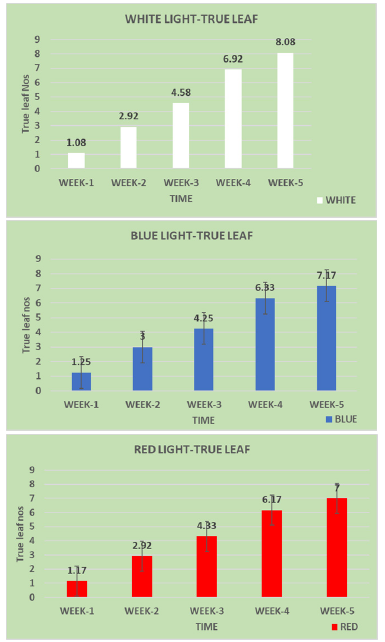
Chlorophyll content
The experiment aimed to analyse the chlorophyll content of kalian plants under different light spectrums over a period of 5 and the WHITE light demonstrated comparable growth. By the final week, all plants had developed a considerable number of true leaves. The BLUE light consistently showed the highest average number of true leaves, with the RED and WHITE light following closely behind.
The results indicate that the BLUE light spectrum had the most pronounced effect on the development of true leaves in Kailan plants throughout the 5-week period. It consistently resulted in a higher average number of true leaves compared to the other light conditions. The RED and WHITE light spectrums also supported significant true leaf development, albeit with slightly slower growth rates. These findings highlight the importance of light spectrum selection in indoor farming and greenhouse environments to optimize the growth and development of leafy vegetables like Kailan (Figure 9).
weeks. The recorded data for chlorophyll content at each week for each light condition (BLUE, RED, and WHITE) are presented below. In the third week, the chlorophyll content of Kailan plants under all three light conditions showed relatively similar values. The WHITE light displayed the highest chlorophyll content at 43.77, followed closely by the BLUE light group at 40.94, and the RED-light at 40.46. Following week, the chlorophyll content increased for all plants under different light spectrums. The WHITE light group exhibited a substantial rise in chlorophyll content, recording the highest value of 49.17. The BLUE light showed a moderate increase to 41.74, and the Red-light also experienced a rise to 42.68. On the fifth week, the chlorophyll content of all plants continued to increase. The BLUE light group reached a chlorophyll content value of 44.00, the Redlight recorded 43.83, and the WHITE light exhibited 46.28.
The results indicate that the chlorophyll content of Kailan plants was influenced by the light spectrum they were exposed to. The WHITE light spectrum demonstrated a significant impact on chlorophyll production, resulting in higher chlorophyll content compared to the BLUE and Red-light spectrums. However, all three light conditions supported chlorophyll synthesis and accumulation in the Kailan plants over the 5-week period. These findings highlight the importance of light spectrum selection in promoting photosynthesis and optimal plant growth in indoor farming and greenhouse environments (Figure 10).
Figure 10:Chlorophyll content in leaves of Kailan.
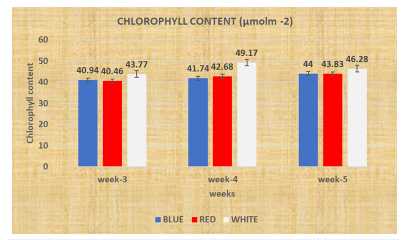
Leaf area
The experiment aimed to measure the leaf area of Kailan leaves under different light spectrums. The recorded data for leaf area for each light condition (BLUE, RED, and WHITE) are as follows: The results indicate that the leaf area of Kailan leaves varied depending on the light spectrum they were exposed to. The largest leaf area was observed in the plants subjected to the WHITE light spectrum, with a measured value of 118.55 square units. The BLUE light spectrum resulted in the second-largest leaf area at 117.09 square units. The RED-light spectrum exhibited the smallest leaf area among the three light conditions, with a value of 103.27 square units (Figure 11). The experiment demonstrates the significant impact of different light spectrums on the leaf area of Kailan leaves. The WHITE light spectrum proved to be the most effective in promoting leaf expansion, resulting in the largest leaf area. The BLUE light spectrum also supported considerable leaf growth, resulting in the second-largest leaf area. The RED-light spectrum, while contributing to leaf development, resulted in comparatively smaller leaf area. These findings highlight the importance of light spectrum selection in influencing leaf growth and overall plant development in controlled environments such as indoor farming and greenhouse setups [6].
Figure 11:Chlorophyll content in leaves of Kailan.
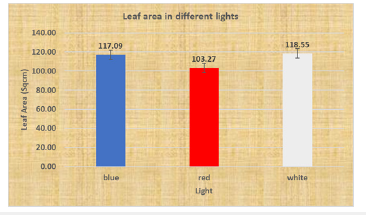
Girth of Kailan internode
The experiment aimed to measure the girth of the internode in Kailan plants during the harvesting season under different light spectrums. The recorded data for internode girth for each light condition (BLUE, RED, and WHITE) are as follows (Figure 12).
Figure 12:Girth of Internode.
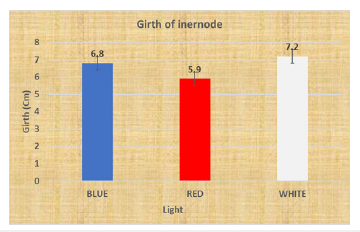
The experiment reveals the significant impact of different light spectrums on the internode girth of Kailan plants during the harvesting season. The WHITE light spectrum proved to be the most effective in promoting internode growth, resulting in the largest girth. The BLUE light spectrum also supported considerable internode development, resulting in a slightly smaller girth. The redlight spectrum, while contributing to internode growth, resulted in the smallest girth among the three light conditions. These findings highlight the importance of light spectrum selection in influencing internode growth and overall plant development in Kailan plants during the harvesting season in controlled environments such as indoor farming and greenhouse setups.
Biomass
The experiment aimed to measure the fresh weight and dry weight of Kailan plants under different light spectrums. The recorded data for fresh weight and dry weight for each light condition (BLUE, RED, and WHITE) are as follows: After harvesting, the highest fresh weight was observed in the plants subjected to the BLUE light spectrum, with a recorded weight of 24.12 grams. The Red-light spectrum resulted in a lower fresh weight of 17.46 grams, while the WHITE light spectrum had a fresh weight of 24.05 grams.
After subsequent drying, the highest dry weight was observed in the plants subjected to the BLUE light spectrum, with a recorded weight of 2.166 grams. The Red-light spectrum resulted in a lower dry weight of 1.218 grams, while the WHITE light spectrum had a dry weight of 1.601 grams (Figure 13 & 14).
Figure 13:Fresh weight of the Kailan Plant.
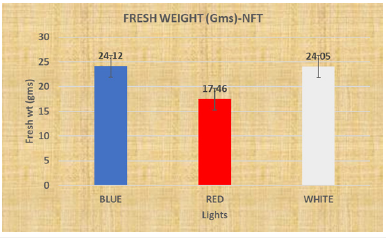
Figure 14:Dry Weight of the Kailan Plant.

The experiment demonstrates the significant impact of different light spectrums on the fresh weight and dry weight of Kailan plants. The BLUE light spectrum proved to be the most effective in promoting plant growth and photosynthetic process [7], resulting in the highest fresh weight before harvesting and subsequently leading to the highest dry weight after harvesting and drying. The Red-light spectrum also supported considerable plant growth, resulting in a lower fresh weight and dry weight compared to the BLUE light. The WHITE light spectrum, while contributing to plant growth, resulted in a fresh weight and dry weight like that of the BLUE light spectrum.
These findings highlight the importance of light spectrum selection in influencing plant biomass accumulation and overall growth in controlled environments such as indoor farming and greenhouse setups. The invention of LED solid-state lighting in the early 1960s, and the recent improvements in technology and pricing have made LED lights commercially feasible in indoor farming [8,9]. Recently, LEDs are extensively used in plant factories compared to fluorescent lamps due to their extended life, decreased heat output, and lower power consumption. Due to lower prices and improved performance, light-emitting diodes (LEDs) have been used as artificial lighting for crop cultivation for the past decade [10,11]. Red (600-700nm) and blue (400-500nm) LEDs light is generally used for growing different plants like spinach [12]. The findings indicate that light spectrum plays a significant role in Kailan growth within the hydroponic NFT system. Blue light proves to be the most favourable spectrum, leading to increased plant height, leaf area, and chlorophyll content. Red light also positively influenced growth, while white light maintained standard performance. The quality of the light is especially important for plant growth when artificial light is used for indoor farming. This provides unprecedented opportunities to fine tune light spectra and PPFD to manipulate crop growth and development. Blue and red LEDs have higher efficacy than white and green LEDs [8].
Statistical Analysis: ANOVA (Analysis of Variance)
“Data analysis was carried out using the ANOVA method. The samples were compared under blue lights, red lights, and white lights. The results indicated a significant difference (p<0.05) among the means at week 6. The ANOVA method was used to compare the means under different light conditions (blue, red, and white lights). The results showed that there is a significant difference (p<0.05) among the means at week 6, suggesting that the light conditions had a significant impact on the outcome measured at this specific time point (Table 2).
Table 2:

In summary, the table shows the results of the ANOVA analysis and whether there are significant differences in the growth parameters under different light conditions. Parameters with p-values less than 0.05 are considered statistically Significant (S), while those with p-values greater than or equal to 0.05 are considered not Statistically Significant (NS).
The p-value (0.035) for the “True leaves” growth parameter is less than 0.05 (α = 0.05), indicating that there is a significant difference in true leaves under the different light conditions (White, Red, and Blue). The p-value (0.08) for the “Height of Plant” growth parameter is greater than 0.05 (α = 0.05), indicating that there is no significant difference in plant height under the different light conditions. The p-value (0.013) for the “Chlorophyll” growth parameter is less than 0.05 (α = 0.05), indicating that there is a significant difference in chlorophyll content under the different light conditions. Leaf area, Girth, Fresh Weight, and Dry Weight: The p-values for these growth parameters are all greater than 0.05 (α = 0.05), indicating that there are no significant differences in leaf area, girth, fresh weight, and dry weight under the different light conditions.
Conclusion
The light spectrum significantly influenced the germination, growth, and biomass production of leafy greens in the hydroponic NFT system. Blue light proved to be the most beneficial, leading to higher germination rates, improved growth parameters, increased chlorophyll content, and enhanced biomass production. Red light also showed positive effects, while white light acted as the control with average results.
These findings emphasize the importance of light quality in hydroponic systems, indicating that selecting appropriate light spectrums can optimize the cultivation of leafy greens, enhancing overall productivity. Further studies focusing on specific light spectra for different plant species would shed light on the underlying physiological mechanisms driving these responses. The effect of different light spectrums on Kailan growth in the hydroponic NFT system is evident. The comparative analysis of the results suggests that the blue light spectrum had the most significant positive impact on the growth of Kailan plants. Blue light promoted the most vigorous growth and enhanced photosynthetic activity, leading to rapid and robust development throughout the 5-week period. The red-light spectrum also supported healthy growth, although it exhibited a slightly slower growth rate compared to the blue light. The white light spectrum, while maintaining steady growth, showed an intermediate effect on plant height. These results highlight the critical importance of selecting appropriate light spectrums to optimize Kailan cultivation in hydroponic NFT systems. The findings have valuable implications for optimizing plant growth in indoor farming and greenhouse environments, where the choice of light spectrum can be tailored to suit the specific requirements of different crops [13].
Further research should delve into understanding the physiological mechanisms behind the varying responses of plants to different light spectrums. Additionally, exploring the potential applications of optimized light spectrums in sustainable agriculture and crop yield enhancement could lead to significant advancements in the field. If there are repeated parts, I have removed them in this version..
References
- He J, Lee S (2012) Impact of climate change on food security and proposed solutions for the modern city. In International Symposium on Soilless Cultivation. pp. 1004-1006.
- Berry JA, Downton WJS (1982) Environmental regulation of photosynthesis. Photosynthesis 2: 263-343.
- Sager JC, Wheeler RM (1992) Application of sunlight and lamps for plant irradiation in space bases. Adv Space Res 12(5): 133-140.
- Das M, Ganguly A, Haldar P (2009) Space requirement for mass rearing of two common Indian acridid adults (Orthoptera: Acrididae) in laboratory condition. Am Euras J Agric Environ Sci 6(3): 313-316.
- Muchena FB, Pisa C, Mutetwa M, Govera C, Ngezimana W (2021) Effect of spent button mushroom substrate on yield and quality of baby spinach (Spinacia oleracea). International Journal of Agronomy 2021: 1-9.
- Novinanto A, Andree WS (2018) The effect of led light source variation toward curly lettuce (Lactuca sativa var. Crispa L) Growth and Yield in Hydroponic Raft System. Agric 31(2): 191-204.
- Wu MC, Hou CY, Jiang CM, Wang YT, Wang CY, et al. (2007) A novel approach of LED light radiation improves the antioxidant activity of pea seedlings. Food Chem 101(4): 1753-1758.
- Kusuma P, Pattison PM, Bugbee B (2020) From physics to fixtures to food: current and potential LED efficacy. Horticulture Research 7: 56.
- Nakamura K, Shimizu H (2019) Plant factories in Japan 319 325 Plant factory using artificial light: Adapting to environmental disruption and clues to agricultural innovation. Elsevier, Amsterdam, Netherlands.
- Piovene C, Orsini F, Bosi S, Sanoubar R, Bregola V, et al. (2015) Optimal red: blue ratio in led lighting for nutraceutical indoor horticulture. Scientia Horticulturae 193: 202-208.
- Kang WH, ParkJS, Park KS, Son ES (2016) Leaf photosynthetic rate, growth, and morphology of lettuce under different fractions of red, blue, and green light from light-emitting diodes (LEDs). Horticulture, Environment, and Biotechnology 57: 573-579.
- Hanyu H, Shoji K (2002) Acceleration of growth in spinach by short-term exposure to red and blue light at the beginning and at the end of the daily dark period. Acta Hort 580.
- He J, Qin L, Liu Y, Choong TW (2015) Photosynthetic capacities and productivity of indoor hydroponically grown Brassica alboglabra Bailey under different light sources. American Journal of Plant Sciences 6(10): 554-563.
© 2023 Shanmugavadivu Ramasamy. This is an open access article distributed under the terms of the Creative Commons Attribution License , which permits unrestricted use, distribution, and build upon your work non-commercially.
 a Creative Commons Attribution 4.0 International License. Based on a work at www.crimsonpublishers.com.
Best viewed in
a Creative Commons Attribution 4.0 International License. Based on a work at www.crimsonpublishers.com.
Best viewed in 







.jpg)






























 Editorial Board Registrations
Editorial Board Registrations Submit your Article
Submit your Article Refer a Friend
Refer a Friend Advertise With Us
Advertise With Us
.jpg)






.jpg)














.bmp)
.jpg)
.png)
.jpg)










.jpg)






.png)

.png)



.png)






